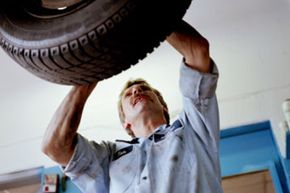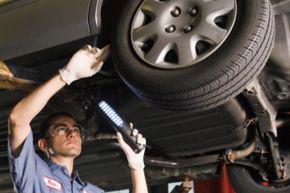\”

The country\’s cargo shipments ride on air, and now your car can, too. Air suspension systems have long been used in the trucking world, but in the last decade or so, they\’ve moved into the commercial world. Motorcycles, all-terrain vehicles, custom cars, performance cars — even everyday commuter cars — are using the suspension systems.
Changes in technology mean that systems are no longer clunky, slow and imprecise. Instead, they use fast, precision-based technology with advanced electronics that control everything from ride height to bag pressure, offering a smooth, controlled drive.
And it\’s about time, as the car\’s suspension system is an often-overlooked area. From a comfort and safety standpoint, your car\’s suspension is integral to how your car drives. Shock absorbers and coil springs help absorb and direct road force, maintaining wheel oscillation, jounce and rebound.
However, every time you add or take away weight to a vehicle, speed up or slow down, or turn left or right, this challenges what the shock absorbers and springs are capable of. Traditional stock shocks and springs are designed and installed with only a fixed set of situations in mind.
Air suspension systems essentially replace a vehicle\’s coil springs with air springs. The air springs are simply tough rubber and plastic bags inflated to a certain pressure and height to mimic the coil springs. But the similarities end there. By adding in an on-board air compressor, sensors and electronic controls, today\’s air suspension systems provide several advantages over all-metal, conventional springs, including near-instant tuning, and the ability to adapt handling to different situations and vary load capability.
Whether the system is manual or electronic, or installed by a weekend mechanic or a seasoned tech, air suspension can lower a car to improve its street cred, even out a heavy payload, or simply improve the ride of a vintage Detroit metal street monster.
Read on to learn more about this trend and what to look for when you want to give your car a lift.
Contents
- Air Suspension System Components
- Solenoids, Valves and Lines
- Air Suspension Kits
- Air Suspension System Installation
Air Suspension System Components
Early versions of air suspension systems were relatively simple. Air bags replaced the coil springs. The bag was inflated to the correct pressure or height with an outside compressor through a valve on the bag. Changes in technology and use added more components, and control, to the system. But today\’s air suspension systems all have a basic stock of similar components that vary little from maker to maker. The differences come mainly in controls and ease of installation.
Air bag material has changed little over time. The bag is a composite of rubber and polyurethane, which provides structural integrity, air-tight construction, toughness against light abrasion from road debris and sand, and resistance to salt and chemical corrosion.
The bags come in three basic shapes:
- Double-convoluted bag. This bag is shaped like an hourglass. The design allows for a little more lateral flexibility than the other designs.
- Tapered sleeve. This air bag performs the same as any other but is designed to fit in a tighter area and offers a little more adjustability on ride height.
- Rolling sleeve. This is also a specific-application air bag. The pertinent differences between the two sleeves are really about ride height and spring control, and what\’s best for the vehicle and the application.
Most air suspension systems now come with an on-board compressor. The compressor is an electric pump feeding air to the bags through a series of compressed air lines. The compressor is generally mounted on the vehicle\’s frame, or in the trunk. The vast majority of compressors come with an attached drier. The compressor works by drawing outside air into the pump, compressing it and moving it to the bags. Outside air is often laden with moisture, and moisture can wreak havoc in a closed system. The drier uses a substance known as a desiccant to absorb as much moisture from the air as possible before the air is sent through the system.
Simpler compressor systems rely on the compressor itself to maintain, increase or decrease pressure. More advanced systems add an air tank to maintain pressure and provide an even transition between pressures. Compressors can be activated manually or automatically, and controlled solely by the driver, automatically through an electronic system, or a combination of both.
Staying Dry
A desiccant is a type of adsorbent, which is a type of substance that holds another substance, such as water, inside itself.
Solenoids, Valves and Lines


Of course, there\’s more to an air suspension system than just a simple bag. Here are the parts the help make an air suspension system work.
Lines carry the compressed air to the bags. The lines are similar to common high-pressure air lines and are routed along the frame of the vehicle. While most lines are a rubber/polyurethane composition, they can be replaced with custom steel lines, offering a cleaner look and a more rugged construction.
Valves are the gateways for the air to enter various parts of the system. In today\’s air suspension system, valves play a critical roll in isolating and controlling where air is directed and how. Early generation air suspension systems were two-way setups. Essentially, each left and right air bag was connected by a line and shared air. As the vehicle cornered, one air bag compressed its air and pushed it through the line to the other air bag, which was expanding. This resulted in severe body roll and accounted for part of the reputation air suspension systems had for causing a terrible ride. Now, systems use a series of valves that control this tendency and offer bettering handling.
Solenoids are used in electronically-controlled systems to fill and vent each air bag. As the system adjusts for different conditions, it commands each solenoid to open or close, changing the amount of air in each of the bags.
Electronic systems are managed through an electronic control module. The controlling software can be very basic, almost a digital version of analog on/off controls, or it might run a more sophisticated software, monitoring pressure and ride height in real time. The modules receive information through a variety of inputs, including ride-height sensors, and toggle the compressor on and off as needed. The electronic side of the system is where most innovation has occurred, and where changes will likely happen in the future. These systems generally remain separate from the vehicle\’s on-board modules and communications.
Air Suspension Kits
Production cars use set shock absorbers and coil springs, and changing those from stock without ruining the car\’s ride or handling takes time, patience and expertise. And choosing a suspension kit can be a daunting task. There are a multitude of manufacturers and companies selling a wide range of components in a bewildering combination of quantity and quality.
Added to the mix is the fact that air suspension kits only replace coil springs, and coil springs are part of a larger suspension system. Given this fact, many companies offer total suspension overhaul kits, where everything from tie rods to control arms and shocks are replaced with high-end components designed to maximize what an air suspension system can offer.
However, in general, the most basic kits come with air bags to replace a vehicle\’s coil springs, along with a compressor and air lines. Most basic kits are a two-way system that can result in heavy body roll. Stepping up the line in price means better components, which means more control and variability, better components, and more speed in making changes.
Buying a kit should not be a casual affair. Owners need to put a lot of thought into what they want from a system. The owner of a classic El Camino show car looking to drop his suspension to new lows would need a different system than a heavy-duty pick-up driver looking for better load capacity and control when hauling tools and building material. Similarly, a race driver would be looking for a different level of performance than the driver of a touring car.
Top-of-the-line kits use a four-way system coupled with an advanced controller. Each air bag is controlled separately, but they\’re linked together by the electronic controller for dynamic and static control. When choosing a kit, consumers also need to understand the differences between pressure systems and ride-height systems.
Pressure-based systems monitor only the air pressure in the bag. This is fine in most cases when you want to do something like preset a pressure to lower a low-rider at a show. However, adding ride-height sensors into the electronic mix brings the kit to a new level. Ride-height systems monitor how much a car raises and lowers while monitoring the pressure needed to reach each level. Ride height and pressure come into play in performance applications as well as work applications, like keeping suspension up on a pickup truck loaded with a few tons of mulch.
Do Your Research
The Internet offers a wealth of information, but it\’s better to talk to an expert, figure out what\’s needed, and set up a budget for a system that will work rather than one that\’s simply inexpensive. Kit prices can range from a few hundred dollars to several thousand.
Air Suspension System Installation


In a little tongue-in-cheek attempt at reverse psychology, RideTech, one of the industry leaders in air suspension systems and components, placed the phrase "Do Not Open" on their installation instructions. The biggest problem people faced in installing their new system was that they never read the instructions. The company felt that maybe people would actually open the manual if they were told not to.
RideTech illustrates a very valuable point. Installation of even complex systems is possible, but people need to read the instructions and follow them. However, an installation should not be attempted by someone with little knowledge of how to work on cars; someone who has never worked on a suspension; or someone who lacks the tools and facilities to do the job safely and competently.
RideTech estimated installation for their muscle car bolt-on kits at 12 to 15 hours for the undercar suspension components, and an additional 10 for the compressor system. Add another five to six hours if you are adding a leveling system. That said, proper installation will go a long way toward saving money by making sure all of the components work right and are set up to avoid the chafing that most often kills an air suspension system.
Air suspension systems are designed to be airtight. Most problems arise when an installer doesn\’t take the proper precautions, usually outlined in the directions, to ensure the system is as airtight as possible. RideTech approximates that 90 to 95 percent of leaks could be prevented if installers used sealer tape on all threads where advised, and routed lines away from possible chafing points.
The company also emphasized being sure that the bags themselves had the proper clearances so they didn\’t rub against part of the car, and that they were clear of hot components like exhaust pipes and mufflers. A careful and diligent installer would provide a system that could easily last more than a decade.
Another thing to consider during installation is tuning. Among the additions suggested by most companies is to change the car\’s shocks at the same time you change the coil springs to air bags. Shocks are designed to work in tandem with springs, and installing a $4,000-plus air suspension system on a vehicle with factory shocks is a waste of money. The change is relatively simple, but it adds another layer of tuning to the entire project.
Air suspension systems are complex and daunting, but they can yield impressive looks and performance if installed and tuned correctly. For lots more information on auto parts, see the links on the next page.
Originally Published: Jun 21, 2012
Air Suspension System FAQ
What is an air suspension system?
Air suspension systems essentially replace a vehicle\’s coil springs with air springs. By adding in an on-board air compressor, sensors and electronic controls, today\’s air suspension systems provide several advantages over all-metal, conventional springs, including near-instant tuning, and the ability to adapt handling to different situations and vary load capability.
What are air springs made out of?
The air springs are simply tough rubber and plastic bags inflated to a certain pressure and height to mimic the coil springs.
Is air suspension good for daily driving?
Whether the system is manual or electronic, or installed by a weekend mechanic or a seasoned tech, air suspension can lower a car to improve its street cred, even out a heavy payload, or simply improve the ride of a vintage Detroit metal street monster.
How much do air suspension kits cost?
Air suspension kit prices can range from a few hundred dollars to several thousand.
What is included in air suspension kits?
Owners need to put a lot of thought into what they want from a system. The most basic kits come with air bags to replace a vehicle\’s coil springs, along with a compressor and air lines. Top-of-the-line kits use a four-way system coupled with an advanced controller.
Lots More Information
Related Articles
- Top 10 Ways to Lower and Lift Your Car or Truck
- 10 Car Accessories That Could Be Dangerous
- What makes certain car accessories unsafe (or even illegal)?
- How Engine Lubrication Systems Work
- Do HHO systems actually work?
Sources
- Knowles, Don. "Automotive Suspension & Steering Systems, 4th Edition." Thomson Delmar Learning. 2007. (Feb. 7, 2011)
- Potter, Georg. RideTech spokesman. E-mail interview. (Feb. 3, 2011)
- RideTech Air Ride Technologies. "Air Suspension Overview." (Feb. 7, 2011) http://www.ridetech.com/tech/air-suspension-overview/












